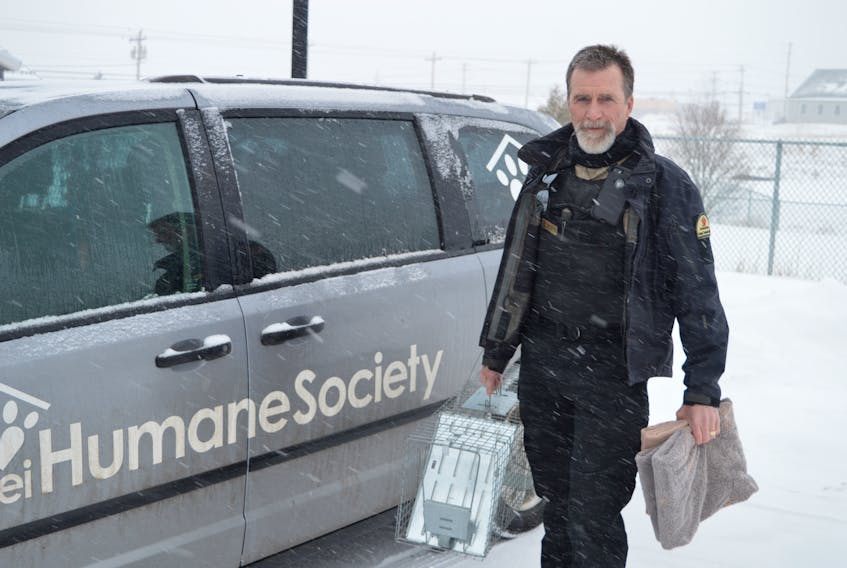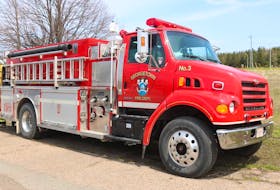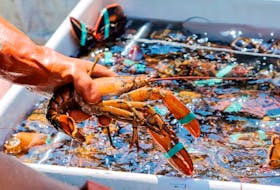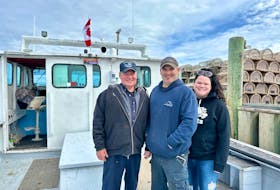CHARLOTTETOWN, P.E.I. — Dave Arsenault of Charlottetown has been an animal lover his entire life.
He and his neighbours in the Maypoint area have been sharing the task of taking care of a stray cat, providing shelter from the cold by doing things like leaving a shed door open and putting food out.
“They are our most vulnerable creatures, just like downtrodden people who are roaming the streets in this kind of weather. They have no place to go,’’ Arsenault said.
Recently, the neighbours noticed the cat was injured.
“We think she’s wounded; probably had a tangle with a fox.’’
So, Arsenault placed a call to the P.E.I. Humane Society.
Mike Gilbertson, one of the society’s animal protection officers, responded. The Guardian tagged along to find out more about what it is these officers do.

Gilbertson checked under Arsenault’s deck, but there was no sign of the cat. So, Gilbertson grabbed some food and blankets and a trap and set it up in Arsenault’s shed.
The officers travel around in vans packed with cages, cat carriers, leashes, collars, muzzles and food.
Arsenault’s call for help is one of about 1,000 cases the animal protection officers deal with each year.
They fill two major roles when it comes to animal protection — animal welfare and animal control. They enforce the animal control bylaw in Charlottetown, Cornwall and Stratford, as well as the provincial animal welfare act where officers deal with calls from the public.
“That can be things like food, water, shelter, dogs out in cold temperatures or abuse cases,’’ Gilbertson said, offering some examples.
Animal protection officers also enforce the provincial Dog Act and work with the Department of Health and Wellness.
Gilbertson is one of three full-time animal protection officers. There are a couple of relief officers as well. Of this handful, one is ex-RCMP, another is former military while the third is a dog trainer. Service is available 24 hours a day. It’s a lot of work, considering they average 1,000 cases annually.
“There’s always someone on call overnight. With three to five of us to a whole province, we’re a little thin on the ground sometimes.’’
Gilbertson said the perfect candidate for the job is someone with a background in enforcement and in animal care.
Gilbertson started with the humane society two years ago, having served as a national park warden dog handler. He trained with the Ontario police K-9 unit.
Outside of calls from the public, a typical day could see one of the officers transporting animals from the humane society shelter on Sherwood Road to the Southport Animal Hospital, which takes care of all the spaying and neutering for the society, or to the Atlantic Veterinary College for medical treatment.
When it comes to animals, these officers are the first responders.
Cases can involve them dealing with animal owners who have mental health or substance abuse issues.
Gilbertson said they deal with hoarding cases – situations where there are too many animals in a house and conditions are unsanitary.
“Those can be difficult to deal with. In some cases, animals have been abandoned for days on end without food, water and care, and we’ll have to intervene on those.’’
Officers have the authority to execute search warrants and issue orders, such as forcing an owner to take a pet to a veterinarian.
“We can seize animals if they’re in immediate distress. We recently seized some animals in distress in a house. The information we received was that they were abandoned. One animal was clearly underweight and clearly hadn’t had access to food and water in a while. The house was full of feces. Those are the extremes we see.’’
On the Saturday before this interview, Gilbertson responded to a call where a dog had been hit by a car. The animal was taken to the vet.
“It’s a tough job to do at times. You see some things that you would rather not see, on the human side and the animal welfare side.’’
They also deal with plenty of strays, ultimately trying to reunite the pet with its owner.
Eventually, they were able to catch that cat, by the way, in the trap Gilbertson had set in Arsenault’s shed, fewer than two days later.
However, the cat tested FIV (feline immunodeficiency virus) positive and had other serious wounds and injuries and had to be humanely euthanized.
Just the facts
- The P.E.I. Humane Society is in the midst of a $2.9-million capital fundraising campaign
- The society wants to transform its shelter into a preventive care facility with a focus on promoting health and wellness
- The shelter needs to address heating issues for the animals, additional hot water, a new ventilation system and additional safety precautions for animals and people









